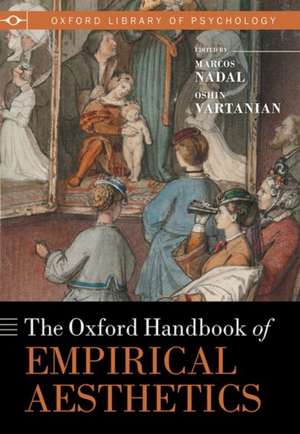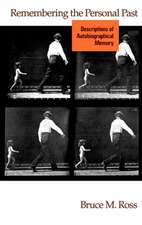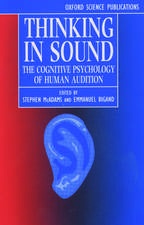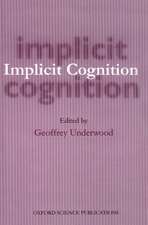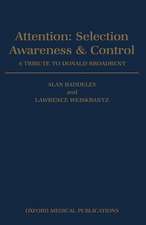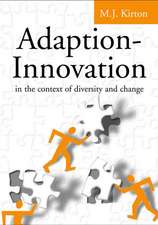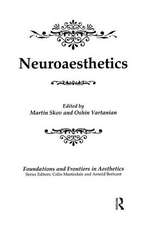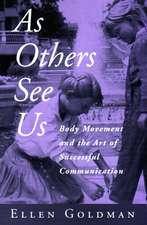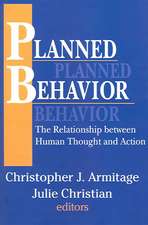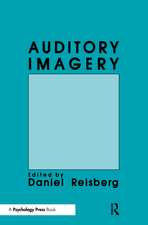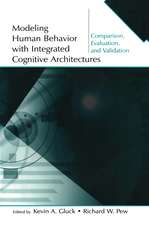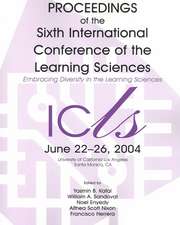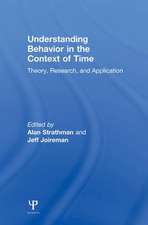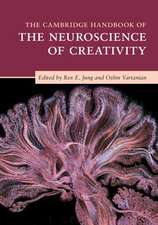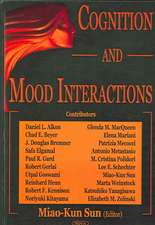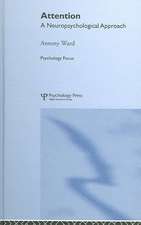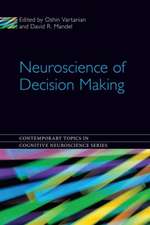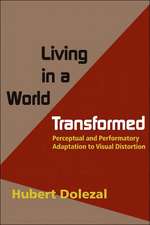The Oxford Handbook of Empirical Aesthetics
Autor Marcos Nadal, Oshin Vartanianen Limba Engleză Hardback – 20 oct 2022
Preț: 774.76 lei
Preț vechi: 1147.13 lei
-32% Nou
Puncte Express: 1162
Preț estimativ în valută:
148.30€ • 161.14$ • 124.65£
148.30€ • 161.14$ • 124.65£
Carte disponibilă
Livrare economică 20-26 martie
Preluare comenzi: 021 569.72.76
Specificații
ISBN-13: 9780198824350
ISBN-10: 0198824351
Pagini: 1104
Dimensiuni: 178 x 252 x 56 mm
Greutate: 2.2 kg
Editura: OUP OXFORD
Colecția OUP Oxford
Locul publicării:Oxford, United Kingdom
ISBN-10: 0198824351
Pagini: 1104
Dimensiuni: 178 x 252 x 56 mm
Greutate: 2.2 kg
Editura: OUP OXFORD
Colecția OUP Oxford
Locul publicării:Oxford, United Kingdom
Recenzii
A must-have for those interested in the psychology of aesthetics, the arts, and subjective experiences that in the past have defied empirical investigation.
How do we respond to and evaluate works of art? How is our response shaped by biology, culture, and/or personality? What methods are used to answer such questions empirically? For all researchers in the field of empirical aesthetics, and for readers outside the field interested in art and the mind, this handbook is an essential resource.
In 1871 Gustav Theodor Fechner conceived of an experimental aesthetics, studying art from below rather than above, using empirical not philosophical methods, studying what is liked rather than what should be liked. The Oxford Handbook of Empirical Aesthetics comprehensively summarises progress in realising Fechner's vision.
Filled to the brim with chapters on every imaginable aspect of the exciting and expanding field of empirical aesthetics. Overseen by masterful editors, this book is required reading for any scholar of the arts.
How do we respond to and evaluate works of art? How is our response shaped by biology, culture, and/or personality? What methods are used to answer such questions empirically? For all researchers in the field of empirical aesthetics, and for readers outside the field interested in art and the mind, this handbook is an essential resource.
In 1871 Gustav Theodor Fechner conceived of an experimental aesthetics, studying art from below rather than above, using empirical not philosophical methods, studying what is liked rather than what should be liked. The Oxford Handbook of Empirical Aesthetics comprehensively summarises progress in realising Fechner's vision.
Filled to the brim with chapters on every imaginable aspect of the exciting and expanding field of empirical aesthetics. Overseen by masterful editors, this book is required reading for any scholar of the arts.
Notă biografică
Marcos Nadal received his B.Sc. in Psychology from the University of the Balearic Islands (Spain) in 2000, and his Ph.D. in Psychology: Human Evolution and Cognition from the same university in 2007. From 2012 to 2015 he enjoyed a postdoctoral fellowship at the Department of Basic Psychology and Research Methods of the University of Vienna. He is Professor at the Department of Psychology at the University of the University of the Balearic Islands. He is the Executive Editor of Empirical Studies of the Arts, and serves on the editorial board of Psychology of Aesthetics, Creativity, and the Arts. He is the co-editor of Art, Aesthetics, and the Brain (OUP Press). His research is devoted to characterizing the psychological, neural, and evolutionary foundations of humans' capacity for aesthetic appreciation and creation.Oshin Vartanian received his PhD in experimental psychology from the University of Maine under the supervision of Colin Martindale. He is the Co-Editor of Psychology of Aesthetics, Creativity, and the Arts, and past Editor of Empirical Studies of the Arts. He is the recipient of the American Psychological Association's (APA) Division 10 Daniel E. Berlyne Award in recognition of outstanding research by a junior scholar. His co-edited volumes include “Neuroaesthetics” (Baywood Publishing Company), “Neuroscience of creativity” (The MIT Press), “Neuroscience of decision making” (Psychology Press), and most recently “The Cambridge handbook of the neuroscience of creativity” (Cambridge University Press). His main areas of interest include the cognitive and neural bases of aesthetics and creativity.
